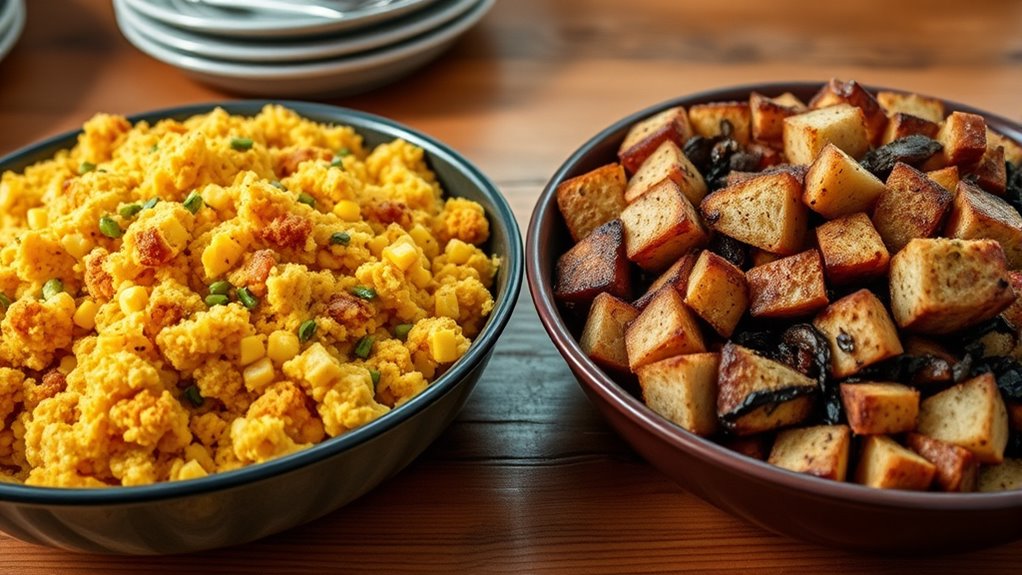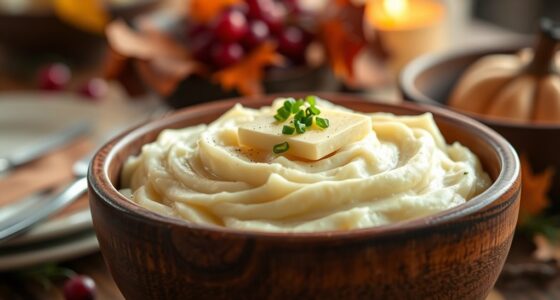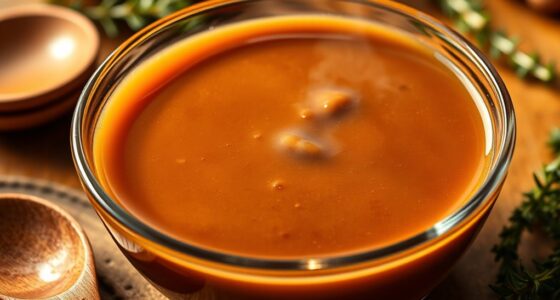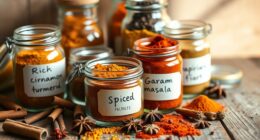Southern cornbread dressing and classic stuffing differ mainly in ingredients and regional roots. Cornbread dressing uses moist, crumbly cornbread, offering a slightly sweet flavor with a crispy top, typical in Southern holiday dishes. Stuffing relies on bread, often baked inside the turkey, giving a hearty texture. Both are seasoned with herbs like sage and thyme but reflect different traditions. If you want to explore their unique qualities and differences, there’s more to discover below.
Key Takeaways
- Southern cornbread dressing features a cornbread base, offering a crumbly, slightly sweet texture, unlike bread-based stuffing.
- Classic stuffing primarily uses bread such as white bread or toast, resulting in a heartier, more bread-like consistency.
- Cornbread dressing is typically baked in a casserole with a crispy top, while stuffing can be cooked inside the turkey or baked separately.
- Southern cornbread dressing emphasizes flavors like sage, thyme, and onions, complemented by its sweet cornbread base; stuffing varies regionally.
- Both dishes can be adapted for dietary restrictions, including gluten-free and vegetarian options, to suit different preferences.

When it comes to holiday table favorites, Southern cornbread dressing and classic stuffing often steal the show, but they’re more than just different names—they’re distinct dishes with unique flavors and textures. As you plan your holiday feast, understanding these differences can help you honor family traditions and accommodate dietary restrictions. Whether you’re cooking for a crowd or just yourself, knowing what sets these dishes apart ensures everyone enjoys the meal.
Southern cornbread dressing is deeply rooted in Southern holiday traditions. Its base is usually made from cornbread, which provides a slightly sweet and crumbly texture. The dish is often seasoned with ingredients like sage, thyme, and onions, giving it a savory, aromatic profile. Because it’s baked in a casserole dish, it develops a crispy top with a moist, tender interior—perfect for scooping and serving. This dressing tends to be less bread-heavy than stuffing, making it a lighter option that still delivers rich flavor. If your family has a long-standing tradition of Southern cooking, cornbread dressing is likely the centerpiece of your holiday table.
Southern cornbread dressing features a savory, crumbly base baked to crispy perfection—ideal for Southern holiday traditions.
In contrast, classic stuffing typically uses bread—white bread, toast, or a mix of both—as its primary ingredient. It’s often cooked inside the turkey or baked separately in a dish, resulting in a moist or crispy texture depending on personal preference. The flavor profile can vary widely but usually includes herbs like sage, parsley, and thyme, along with vegetables such as celery and onions. Because bread is the main ingredient, stuffing tends to be more filling and has a hearty, bread-like consistency. This dish has become a staple in many regions across the country, especially in the North and Midwest, and is often linked to Thanksgiving traditions.
Understanding the role of mediterranean herbs and spices like sage and thyme in both dishes can help you customize flavors to your liking. When considering dietary restrictions, these dishes can be adapted easily. For those avoiding gluten, cornbread dressing can be made with gluten-free cornbread, and stuffing can be prepared with gluten-free bread or alternative grains. Vegetarians and vegans can customize both dishes by omitting animal products—using vegetable broth, plant-based butter, or adding vegetables and nuts for extra flavor and texture. For individuals with food allergies, ingredients like nuts, dairy, or specific herbs can be substituted to create a safe, inclusive dish.
In the end, whether you choose Southern cornbread dressing or classic stuffing, understanding their origins and how they can be tailored to fit various dietary needs allows you to keep your holiday traditions alive while ensuring everyone feels included. Both dishes hold a special place at the table, and knowing their differences helps you make the best choice for your celebration.
Frequently Asked Questions
Can Southern Cornbread Dressing Be Made Vegan?
Yes, you can make Southern Cornbread Dressing vegan by using vegan substitutions and plant-based ingredients. Swap eggs with flaxseed or applesauce, and replace dairy products with plant-based milk and margarine. Use vegan cornbread and add vegetables like celery, onions, and herbs for flavor. This way, you preserve the traditional taste while ensuring it’s completely vegan-friendly, making it perfect for any plant-based gathering.
What Are the Best Herbs for Southern Cornbread Dressing?
You should use herbs with rich flavor profiles like sage, thyme, and rosemary to elevate your southern cornbread dressing. Fresh herbs offer a brighter, more vibrant flavor, perfect for a lively taste, while dried herbs bring concentrated, earthy notes that work well if you want a more intense herbal presence. Combining both can add depth, so choose based on your preferred herb intensity and flavor balance for a delicious dressing.
How Do You Store Leftover Stuffing or Dressing?
Imagine tucking a vintage radio into a cozy drawer—your leftover stuffing needs similar care. Store it in an airtight container in the fridge for up to 3-4 days. For reheating, use a microwave or oven, adding a splash of broth to keep it moist. Storing tips include cooling it quickly and sealing it tightly, ensuring your dressing stays flavorful and safe for your next delicious meal.
Is There a Gluten-Free Version of Cornbread Dressing?
Yes, you can make gluten-free cornbread dressing by using gluten-free alternatives for traditional ingredients. For cornbread substitutions, choose gluten-free cornmeal and add gluten-free baking powder. To guarantee your dressing stays gluten-free, avoid bread crumbs containing gluten and opt for gluten-free options like rice or gluten-free bread crumbs. With these adjustments, you get a delicious, safe cornbread dressing that aligns with your dietary needs.
Can You Prepare Southern Cornbread Dressing Ahead of Time?
Think of making southern cornbread dressing ahead of time as planting seeds for a delicious feast. You can prepare it several days in advance, make ahead preparation easy, and even freeze leftovers for later. Just store it tightly wrapped or in an airtight container. When you’re ready to serve, reheat thoroughly. This way, you save time and make sure your dressing tastes just as fresh and flavorful as if it were made on the day.
Conclusion
Whether you prefer Southern cornbread dressing or classic stuffing, both bring unique flavors to your table. Did you know that about 60% of Americans favor stuffing with bread, while a flavorful 40% opt for cornbread dressing? Whichever style you choose, it’s all about making the holiday meal your own. So, experiment, savor, and enjoy the rich traditions behind each dish—your perfect stuffing or dressing awaits!








